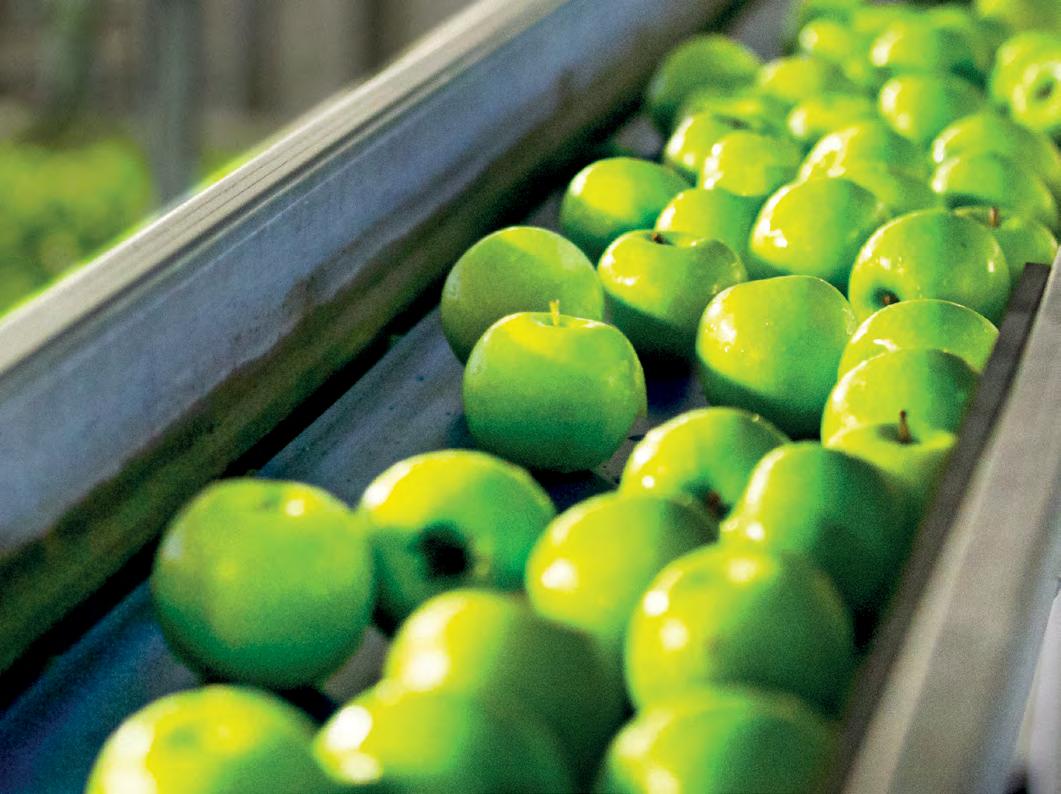
8 minute read
Where is the fork? The missing link in farm-to-fork food safety strategies
Words by Dipon Sarkar
In 2015, the World Health Organisation (WHO) estimated that one in ten people suffered from foodborne disease, with 420,000 annual deaths globally. Comprehensive strategies to ensure food safety at all stages of production, distribution and consumption, such as farm-to-fork and
‘One Health’ approaches have been identified as possible ways to reduce this burden.
Quantitative microbial risk assessment (QMRA) has been established as an internationally recognised tool for supporting food safety risk management over the entire food chain and providing a scientific basis for decision-making.1 According to
Codex Alimentarius guidelines, QMRA considers the microbial behaviour from primary production through to processing, retail and the consumer’s plate (the ‘farm-to-fork’ continuum2) to generate final public health risk estimates.
The consumer phase (CP), or ‘fork’ level, is the final step in the supply chain, where the consumer transports, stores, prepares and consumes food. In QMRA, this stage is represented by a consumer phase model (CPM), that links the production and retail phases with the ultimate public health outcomes generated by the QMRA model.
The CP is unique, as there is a great degree of variability in consumer practices that cannot be enforced by legislation, resulting in reduced interest from food safety professionals in the CP. But consumer risk perception, awareness and practices have been identified as one of the most important interventions for the reduction of foodborne illness. Several foodborne illnesses such as salmonellosis and campylobacteriosis can be significantly reduced by following proper personal hygiene, avoiding cross-contamination during meal preparation and ensuring correct cold storage and heat treatment steps.3 The cultural, social, and geographical differences in food handling behaviour add further difficulty in gathering representative data, leading to a scarcity in data in CP.4
However, researchers have established the importance of a representative CPM to generate meaningful risk estimates in QMRA,5 as attempts to use a simplified ‘universal’ CPM represented by a constant factor that ignores the variability in consumer practices have resulted in significant over estimation of the final risk estimate.6
Some important data considerations for CPM are food storage time and temperature, preparation practices, risk perception, kitchen hygiene condition, cooking temperature and crosscontamination probability. Among these, food safety risk perception is the most studied area,7 with data from other areas being scarce, geographically limited or outdated.
In the absence of this data, assumptions and surrogate data are used to design CPM. For example, recent QMRA studies conducted to estimate the risk of Escherichia
coli O157:H7 from cos lettuce8 and Campylobacter jejuni from chicken consumption9 in Australia have relied on home refrigeration data collected in the USA in 2010 and a consumer behaviour survey conducted in Australia in 1999. In the absence of contemporary representative data, information collected in other geographical locations is used, or a survey conducted over two decades ago may be one of the most reliable sources of data, even if food habits have significantly changed since the data was originally collected. Moving forward, this limitation will have further implications, with the increasing changes in consumer preference, diets, demography, and the growing popularity of alternative proteins.
Along with academic research projects conducted by government agencies and universities, innovative approaches such as citizen science projects and crowd-sourcing projects can play a key role in addressing data gaps in CP.10,11 Citizen science empowers public participation in scientific research through co-creation, data monitoring and collection programs. Such approaches can engage the wider community to rapidly generate large amounts of data within homes and capture variability in CP whilst also increasing awareness of the data used for policy decisions.
This approach has been demonstrated in several food-related citizen science projects, such as those used in meat temperature monitoring12 and household waste estimation.13 The UK Food Standards Agency have identified the potential of citizen science methodologies for addressing food safety challenges and funded several projects investigating issues such as antimicrobial resistance, food hypersensitivity and hygiene conditions in domestic kitchens.
Overall, this article seeks to highlight a significant data gap in ‘fork’ level data that can be used in food safety management and emphasises a need for additional research through citizen science, survey and crowd-sourcing projects. This would help us better understand, monitor and quantify food safety risk at the ‘fork’ level, ultimately providing better food safety education and communication to consumers.

References
1. Koutsoumanis, K. P. & Aspridou, Z. Moving towards a risk-based food safety management.
Current Opinion in Food Science 12, 36–41 (2016). 2. Codex Alimentarius Commision. Codex
Alimentarius Commission. Principles and
Guidelines for the Conduct of Microbiological Risk
Assessment. 1–4 (1999). 3. Bearth, A., Cousin, M. E. & Siegrist, M. Poultry consumers’ behaviour, risk perception and knowledge related to campylobacteriosis and domestic food safety. Food Control 44, 166–176 (2014). 4. Redmond, E. C. & Griffith, C. J. Consumer food handling in the home: a review of food safety studies. J Food Prot 66, 130–161 (2003). 5. Nauta, M. & Christensen, B. The Impact of
Consumer Phase Models in Microbial Risk Analysis.
Risk Analysis 31, 255–265 (2011). 6. Neves, M. I., Mungai, S. N. & Nauta, M. J. Can stochastic consumer phase models in QMRA be simplified to a single factor? Microbial Risk
Analysis 8, 53–60 (2018). 7. Machado Nardi, V. A., Teixeira, R., Ladeira, W. J. & de Oliveira Santini, F. A meta-analytic review of food safety risk perception. Food Control 112, 107089 (2020). 8. Bozkurt, H., Bell, T., van Ogtrop, F., Phan-Thien, K. Y. & McConchie, R. Assessment of microbial risk during Australian industrial practices for
Escherichia coli O157:H7 in fresh cut-cos lettuce:
A stochastic quantitative approach. Food
Microbiology 95, 103691 (2021). 9. Habib, I., Coles, J., Fallows, M. & Goodchild, S.
Human campylobacteriosis related to crosscontamination during handling of raw chicken meat: Application of quantitative risk assessment to guide intervention scenarios analysis in the
Australian context. International Journal of Food
Microbiology 332, 108775 (2020). 10. Reynolds, C., Pateman, R. & Elliott, C. This is a repository copy of Citizen science and food:
A review. Citizen Science and Food: A Review. (2020). 11. Mei, J., Mei Soon, J. & Sam Saguy, I. Article
Crowdsourcing: A new conceptual view for food safety and quality Crowdsourcing: A new conceptual view for food safety and quality 1.
Food Science and Technology 66, 63–72. 12. Developing a Citizen Science Method to Collect
Whole Turkey Thermometer Usage Behaviors - International Association for Food Protection. https://foodprotection.org/publications/foodprotection-trends/archive/2019-09-developing-acitizen-science-method-to-collect-whole-turkeythermometer-usage-behaviors/. 13. Pateman, R. M. et al. Citizen Science for
Quantifying and Reducing Food Loss and Food
Waste. Frontiers in Sustainable Food Systems 4, 247 (2020).
Dipon Sarkar is a PhD candidate at the Tasmanian Institute of Agriculture, University of Tasmania. His research focuses on the development and use of predictive models and risk analysis to ensure the microbial safety of cheese. Dipon was the recipient of the 2022 John Christian Young Food Microbiologist Award. This article is based on his winning abstract and presentation. f
Errata 2022
1. Dr Dai Suter ‘Opportunities for linseed in Australian food products’ Vol.74(2) April-June 2022, p.23 Table 1. Data for Quinoa. The correct values are: Energy kJ - 1518; Protein % - 10.6; Carbohydrate % - 62.0; Total Dietary Fibre % - 7.7; Total Fat % - 6.0; Alpha Linolenic Acid % - 0; Monounsaturated Fatty Acids % - 0.5; Linoleic Acid % - 0; Saturated Fatty Acids % - 0.8; W-9 Fatty Acids - 0 2. Anne Maree Weston, By the Numbers, Vol.74(1) January-March 2022, p.5 In graphics box titled Composition of food export by value (5 year average) - Top 6, all dollar values should be ‘billions’.
Food Safety Information Council celebrates its 25th anniversary
Words by Lydia Buchtmann
The Food Safety Information Council (FSIC) is celebrating 25 years of educating consumers about food safety this year. The Council was originally founded in August 1997 as the Food Safety Campaign Group by the Australian Supermarket Institute, government food agencies, CSIRO and consumer and professional groups. FSIC is now a registered charity with more than 50 members including AIFST, Environmental Health Australia, CSIRO, FSANZ, Choice, state and territory food and health agencies, Dietitians Australia, industry groups and several local government organisations.
The Council’s aim is to reduce the estimated 4.1 million cases of food poisoning in Australia that result in 31,920 hospitalisations, 86 deaths and 1 million visits to doctors every year.
Over time we have seen considerable improvement in consumer knowledge regarding the importance of food safety basics such as effective handwashing, cross contamination, cooking temperatures and safe refrigeration and storage.
Our work is evidence-based, using the best available science and social science. Our main activity is Australian Food Safety Week each November which kicks off our Summer campaign of TV and radio community service announcements, media interviews and videos shown in medical practices.
We also drive numerous campaigns throughout the year including advice not to pick or eat wild mushrooms, promotion of our latest handwashing research is published each Global Handwashing Day, and warnings not to purchase food sold illegally on social media.
We work closely with schools encouraging younger students to wash their hands properly using the Glitterbug UV light experiment and run a National Science Week project each August – this year we’ll be looking at fermenting and preserving food in glass.
If you would like become involved you can find out more at: www. foodsafety.asn.au
Lydia Buchtmann is Communication Director at the Food Safety Information Council. Mob: 0407 626 688. Email: info@foodsafety.asn.au f

23 26 JULY 2023
Melbourne Convention & Exhibition Centre
Redefine the future of food


What you do matters
Find out more & Register now
We are in a time of transition where environmental awareness and future thinking is stepping up to lead consumer led solutions for the food and beverage manufacturing industry.
foodpro is the leading food and manufacturing event that brings all the industry expertise to one place. Showcasing design innovations, new technology, and the latest packaging and processing solutions, foodpro is where the food industry gathers to generate solutions towards a more sustainable world. It’s about creating. Together.










